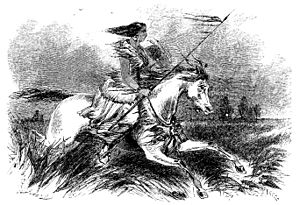Woman Chief facts for kids
Quick facts for kids
Woman Chief
|
|
|---|---|

An old drawing of "Pine Leaf", who might be Woman Chief, from James Beckwourth's book
|
|
| Crow chief and warrior | |
| Personal details | |
| Died | 1854 Fort Union |
| Cause of death | Killed by the Gros Ventres |
Bíawacheeitchish, also known as Woman Chief (born around 1806 – died 1858), was a brave leader and warrior of the Crow people. From a young age, she was interested in activities usually done by men. She became one of the Crow's most important leaders. She even joined the Council of Chiefs as the third highest-ranking member. Many visitors from Western countries were very interested in her. Some people think she might be the same person as "Pine Leaf", a warrior described by James Beckwourth. However, parts of Beckwourth's story might not be completely true.
Contents
The Life of Woman Chief
Early Life and Skills
Woman Chief was born into the Gros Ventres people. We do not know her birth name. When she was about 10 years old, Crow warriors captured her during a raid. A Crow warrior adopted her and raised her among his people.
She showed a strong interest in activities usually done by boys and men. Her foster father encouraged her because he had lost his own sons. Woman Chief became very skilled at riding horses, shooting accurately, and preparing buffalo after a hunt. Even though she took on male roles, she still wore traditional women's clothing. When her foster father passed away, she took over leading his family group.
Becoming a Respected Warrior
Woman Chief became famous as a warrior during an attack. The Blackfoot people raided a fort where Crow and white families were staying. Reports say she fought off many attackers. She played a key role in making the Blackfoot retreat.
After this, she gathered her own group of warriors. They raided Blackfoot villages, taking many horses and scalps. Because of her brave actions, she was accepted into the Council of Chiefs. This council was where the leaders of the Crow people made decisions. She was given the name Bíawacheeitchish, or Woman Chief. She eventually became the third highest-ranking chief among the Council's 160 family groups. She married four wives, which showed how wealthy and important her family group had become.
Peace and Final Days
Woman Chief also helped with peace talks. After the 1851 Treaty of Fort Laramie, she worked to make peace with other tribes in the Upper Missouri area. She successfully made peace with the Gros Ventres, the tribe she was born into. After several years of peace, Woman Chief was attacked and killed by a Gros Ventres group.
Meeting Western Visitors
Western visitors like Edwin Denig and Rudolph Kurz met Woman Chief. They were very interested in her. They often saw her as an unusual and interesting person. This was because Crow society was usually led by men. They compared her to the Amazons from old European stories. Today, we know that their writings might have been biased. However, they still give us important details about Woman Chief's life.
James Beckwourth wrote about a Crow warrior named Bar-chee-am-pe, or Pine Leaf. This warrior might be Woman Chief. Some parts of Pine Leaf's life match what we know about Woman Chief. But Beckwourth's story seems to be greatly exaggerated. Some parts might even be made up. Beckwourth said he met Pine Leaf in the 1820s while living with the Crow. He wrote that she was a very strong warrior. He claimed she promised to kill one hundred enemies before she would marry. He also said he had a romantic relationship with her and asked her to marry him. Some historians, like Bernard DeVoto, believe Beckwourth made up or exaggerated parts of his story. This was especially true for numbers, love stories, and how important he was.
Besides Woman Chief, there were other known women warriors among the Crow Nation. These included Akkeekaahuush (Comes Toward The Near Bank, born around 1810 – died 1880) and Biliíche Héeleelash (Among The Willows, born around 1837 – died 1912). Biliíche Héeleelash was a very important war leader.

